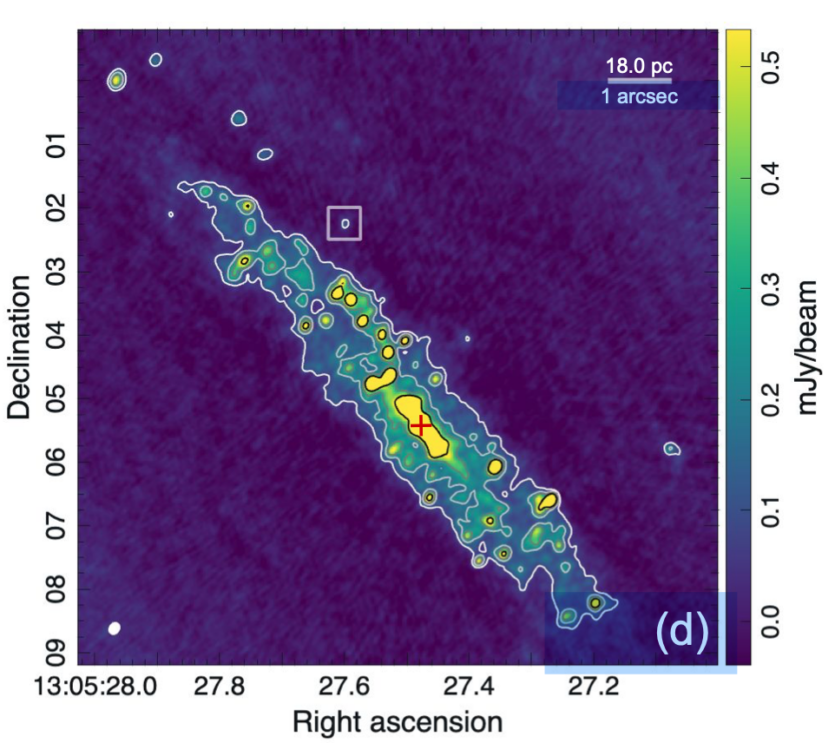
A group of astronomers from the Institute of Astrophysical Research at the University of Diego Portales in Chile has discovered an extremely powerful one, mysterious object in our neighboring galaxy, called Punctum, is unlike anything scientists have ever encountered before.
It is noted, that the mysterious object can currently be observed only in the millimeter-wave range of radio waves. The discovery was made by a group of astronomers, led by Olena Shablovinska, who discovered strange object, using the ALMA Large Telescope in the chilean Atacama desert.
“Beyond the region of supermassive black holes, Punctum is really powerful”, — Shablovinskaya notes.
Astronomers do not yet understand, what this object actually is. What is known, is that it has a compact size and a surprisingly structured magnetic field. In fact, it emits a large amount of energy.
“To put this in context, Punctum is spectacularly bright — 10-100 thousand times brighter than typical magnetars, about 100 times brighter than microquasars, and 10-100 times brighter than every known supernova. Among the stellar sources in our galaxy, it is surpassed only by the Crab Nebula”, — Shablovinska explains.
The mysterious object is located in the galaxy NGC 4945, which is 11 million light-years from Earth and quite close is adjacent to the Milky Way. The galaxy is outside the Local Group, but Punctum cannot be seen in the optical or X-ray range. It is visible only in the millimeter-wave radio range. It is expected, that in the future this object will be studied, using the James Webb telescope in the near and mid-infrared ranges.

The brightness of this object remained unchanged in several observations made in 2023. This means, that it is not a flare or some other short-term phenomenon. Millimeter-wave radiation typically comes from cold objects, such as young protoplanetary disks and interstellar molecular clouds. However, high-energy phenomena, such as quasars and pulsars, can generate radio waves through synchrotron radiation, in which charged particles moving at close to the speed of light describe a spiral around magnetic field lines and emit radio waves.
Based on the strength of polarization of light in the millimeter range, the researchers concluded, that Punctum should have a highly structured magnetic field. According to Shablovinska, the radiation, observed by astronomers, is synchrotron radiation. Objects with strong polarization tend to be compact, because larger objects have chaotic magnetic fields that neutralize any polarization.
Astronomers do not rule out, that the source of this synchrotron radiation can be a magnetar, which is a pulsar with a powerful magnetic field. But although the ordered magnetic field fully satisfies all the requirements for magnets, magnets in the millimeter range are not as bright and powerful as Punctum.
Supernova remnants, such as the Crab Nebula, which are the messy stuffing of a star ejected into space in 1054 AD, shine brightly in the millimeter-wave range. The problem, is that the remnants of the supernova are quite large — the crab nebula itself has a diameter of about 11 light-years — while Punctum is obviously much smaller and more compact.
“At the moment, Punctum really stands alone — it doesn’t fit into any of the known categories. And, to be honest, nothing like this has been observed in any of the previous millimeter-wave surveys, mainly because until recently we didn’t have anything as sensitive and as accurate as ALMA”, — notes Olena Shablovinska.
There are also a warning, that Punctum may be an anomaly — an extreme version of an object, known to astronomers, the same magnetar in an unusual environment, or the remnants of a supernova, interacting with dense matter. This object is 100 times fainter, than the active core of the galaxy NGC 4945, which is powered by the energy of from a supermassive black hole. It is likely, that astronomers would not have been able to see Punctum at all, if it were not for its surprisingly powerful polarization.
The observations that discovered Punctum, focused on the bright active core of NGC 4945. “Punctum came into view only by chance. In future observations of this object with ALMA, it will be possible to achieve much lower noise levels without worrying about the bright core of the galaxy being over-illuminated, and it will be possible to observe it at different frequencies.
“The high resolution and wide spectral range of JWST may help to clarify whether the emission of Punctum is purely synchrotron or includes dust or emission lines”, — Shablovinskaya hopes.
Preliminary results of the study are available on Astro.ph
Source: LiveScience

Spelling error report
The following text will be sent to our editors: